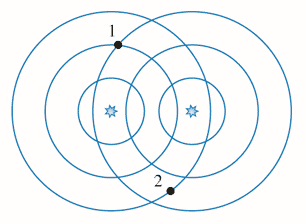Light Superposition and Interference Phenomena

When two identical waves (same wavelength $\lambda$ and same amplitude) arrive at the point P in phase- that is, crest-to-crest and trough-to-trough. According to the principle of linear superposition, the waves reinforce each other and constructive interference occurs. The resulting total wave at P has an amplitude that is twice the amplitude of either individual wave, and, in the case of light waves, the brightness at P is greater than that due to either wave alone. The waves start out in phase and are in phase at P because the distances between this spot (point P) and the sources of the waves differ by one wavelength $\lambda$.
When two identical waves arrive at the point P out of phase with one another, or crest-to-trough. Now the waves mutually cancel, according to the principle of linear superposition, and destructive interference results. With light waves this would mean that there is no brightness. The waves begin with the same phase but are out of phase at P because the distances through which they travel in reaching this spot differ by one-half of a wavelength.
Digital Figure: constructive interference
|
Digital Figure: destructive interference
|
|---|
Young's Double-Slit Experiment
In 1801 the English scientist Thomas Young (1773-1829) performed a historic experiment that demonstrated the wave nature of light by showing that two overlapping light waves can interfere with each other. His experiment was particularly important because he was also able to determine the wavelength of the light from his measurements, the first such determination of this important property.
Thin-Film Interference
Young's double-slit experiment is one example of interference between light waves. Interference also occurs in more common circumstances. For instance, a thin film such as gasoline floating on water.
The Michelson Interferometer
An interferometer is an apparatus that can be used to measure the wavelength of light by utilizing interference between two light waves. One particularly famous interferometer was developed by Albert A. Michelson (1852-1931). The Michelson interferometer uses reflection to set up conditions where two light waves interfere.
Virtual Investigations: Double-Slit Interference
|
Digital Figure: a thin film of gasoline
|
|---|
Diffraction
As we have seen in sound, diffraction is the bending of waves around obstacles or the edges of an opening. Sound waves that leaving a room through an open doorway and bend, or diffract, around the edges of the opening. Therefore, a listener hears the sound even when he is around the corner from the doorway.
Diffraction is an interference effect, and the Dutch scientist Christian Huygens (1629-1695) developed a principle that is useful in explaining why diffraction arises. Huygens' principle describes how a wave front that exists at one instant gives rise to the wave front that exists later on. This principle states that:
Every point on a wave front acts as a source of tiny wavelets that move forward with the same speed as the wave; the wave front at a later instant is the surface that is tangent to the wavelets.
Resolving Power
The resolving power of an optical instrument, such as a camera, is its ability to distinguish between two closely spaced objects. For example, for a telescope used to view distant stars or for a microscope used to view tiny organisms. We will now see that diffraction occurs when light passes through the circular, or nearly circular, openings that admit light into cameras, telescopes, microscopes, and human eyes. The resulting diffraction pattern places a limit on the resolving power of these instruments.
The Diffraction Grating
Diffraction patterns of bright and dark fringes occur when monochromatic light passes through a single or double slit. Fringe patterns also result when light passes through more than two slits, and an arrangement consisting of a large number of parallel, closely spaced slits called a diffraction grating has proved very useful.
X-Ray Diffraction
Not all diffraction gratings are commercially made. Nature also creates diffraction gratings, although these gratings do not look like an array of closely spaced slits. Instead, nature's gratings are the arrays of regularly spaced atoms that exist in crystalline solids. so we might expect a crystalline array of atoms to act like a grating with roughly this "slit" spacing for electromagnetic waves of the appropriate wavelength.
Digital simulations: Single-Slit Diffraction
|
Animated Physics: Diffraction
|
Concept Map: Light Waves
|
|---|---|---|
Interactive Demonstration: Interference
|
Interactive Demonstration: Diffraction Gratings
|
You don`t have permission to comment here!
Report